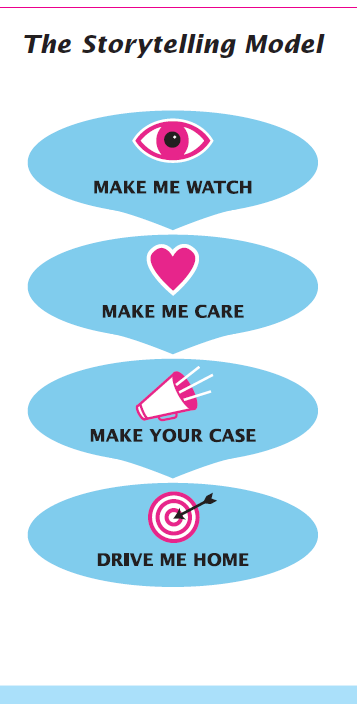The Power of Story Telling
 The Storytelling Model
The Storytelling Model
Anyone developing print or oral material to present to their chosen audience can appreciate the need to organize their content to have the optimum impact.
Whether you are developing prepared material for a presentation, speech, seminar, case study, media opportunity or to promote a cause or achievement, you can use the following simple formula to stay in control of your messaging and to make sure your audience will remain engaged.
Determine the Focus of Your Story: Before you start, it is critical that you take a minute to summarize what you want to say in one or more clear, concise and interesting sentences. If you do so your material will have more impact. The act of boiling down your point is a valuable exercise in focus that can make all the difference to developing a winning presentation.
Next Step: Divide your Presentation into the following Four Blocks:
1) Make Me Watch -- In the first 30 seconds of a presentation, the audience is deciding whether they like you and where you are taking them. So, you need to grab your audience and get their attention right off the bat. Start off a short personal story anecdote, parable, example, or thoughtful question. Make sure it relates directly to what you will be speaking about and this will prime your audience to hear more.
2) Make Me Care -- Remind your audience why they are here; why are you telling them this story; and why should they care about it? A lot of speakers forget to do this and as a result, they lose their audience and never get them back.
3) Make Your Case – This is the meat of your presentation, the information or material you want to cover. People can only remember Three Key Points in a presentation, so don’t overload your speech with too much content.
4) Drive Me Home -- This is your final word, so take this opportunity to leave the audience with one thought or idea that you want people to walk away and think about. Overall, remember that your goal is to impact your audience in a way that inspires and motivates them. They are there to learn something and also to be entertained. Great communications strike just the right balance between these things, and most importantly, drives your agenda with a call to action such as, engaging with you and your organization.
Brought to you by The Success Story Program™ www.successstoryprogram.com

.png)












